Athearn Trains 50-Foot Ice Bunker Reefer
Published: 2021-11-01 - By: CNW400
Last updated on: 2021-10-14
Last updated on: 2021-10-14
visibility: Public - Headline
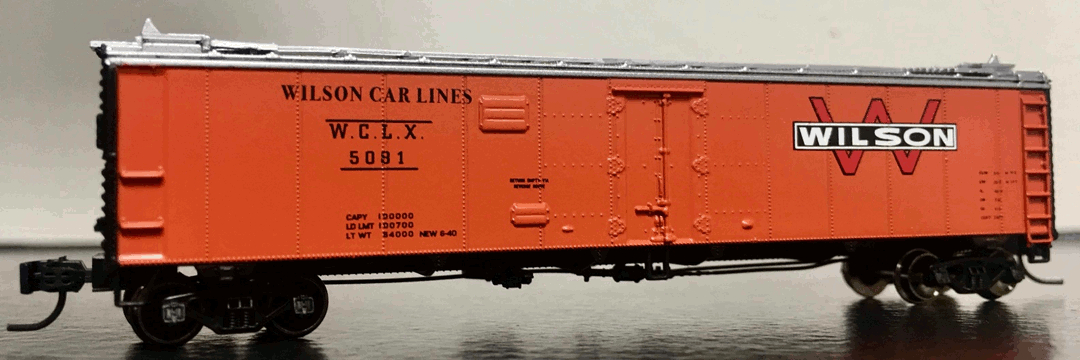
In August 2021, Athearn Trains expanded their 50-foot Ice Bunker Refrigerated Car collection with the release of five road schemes. First released by Athearn in 2006, this model represents the 50-foot steel Santa Fe Rr-30 models produced during the years of 1939 & 1940. With the prospect of abundant war-time traffic, Santa Fe ordered 100 cars from General American Transportation (road numbers 37290-37389). The cars were decorated with the Super Chief slogan on one side and the road map logo on the opposite side. The Athearn model closely resembles the first seventy-five cars produced for Santa Fe as the last twenty-five refrigerated cars were built with Preco air-circulating fans not exhibited on this model.
Also made available are:
My review includes observations of Wilson Car Lines (WCLX) #5081 – Athearn Trains stock number ATH2375.
Sutherland’s railcar design included ice tanks (bunkers) at each end of an insulated car to cool the load. The ice bunkers were manually filled through hatches on the car roof. Intake vents located atop the railcar allowed air to pass over the ice and circulate the cool air throughout the car. These early refrigerated cars were all wood construction between 28 to 32 feet long with wooden underframes and truss rods. The cars had vertical sheathing double walls with insulation between the voids. Early insulation was inadequate, usually sawdust, charcoal or animal hairs that tended to settle to the bottom on the car and left uninsulated areas along the higher portions of the car. At the turn of the 20th century the refrigerated car grew to 36-feet with 20-ton capacity along steel underframes and felt animal hair blanket insulation. Furthermore, swinging hinged doors became commonly used for their tighter seal over conventional doors and the fact that these doors were built thicker and had better insulation properties.

AAR Classes
The refrigerated car matured along with the expanding national railroad systems. The post-World War I period saw the growth of the reefer to 40-feet, 30-ton capacity with steel roofs. Over 60% of the meat reefers built during this era were equipped with brine tanks instead of standard ice bunkers at each end of the car. The brine tanks held a mixture of crushed ice and salt that provided a much lower interior temperature than ice alone. The brine tanks did create a problem for the railroads with drippings of the salt concoction causing corrosive damage to the railcar, tracks, and bridges and the extensive cleanup needed at the end of each trip.
During the World War II era 40-foot riveted steel side panel reefers were introduced with a 40-ton capacity. Steel dreadnaught ends and better insulation (Celotex, cork, and fiberglass) became common. Although 40-feet in length, the refrigerated car had smaller interior load accommodations than a boxcar of the same size. Each end possessed an ice bunker 3-feet in length and the thickness of insulated walls and ceiling hatches made an interior dimension closer to 33-feet in length, 8-feet wide and 7-feet high. The car required 9,000 to 11,000 pounds (about twice the weight of an elephant) of ice to fill the bunkers and depending on the length of the trip, would require stops along the way to be ‘re-iced’.
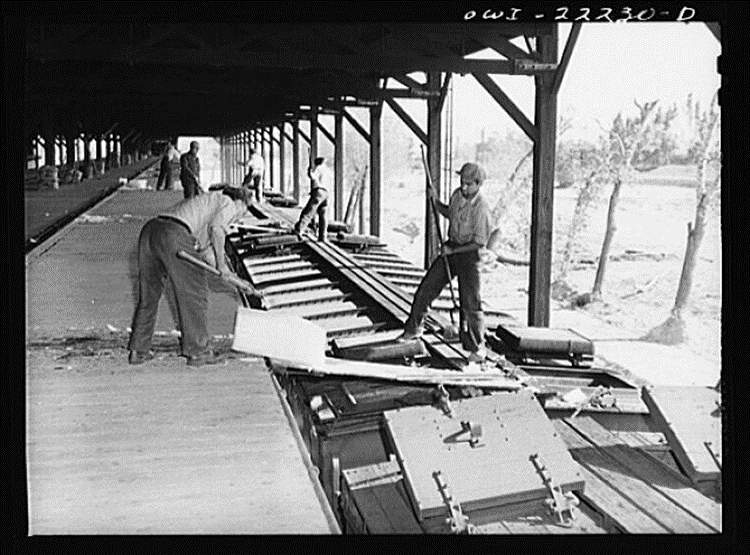
Icing refrigerator cars at the Atchison, Topeka, and Santa Fe Railroad icehouse- March 1943
Library of Congress Farm Security Administration/Office of War Information Black-and-White Negatives Public Domain
Delano, J., photographer. (1943) San Bernardino, California. United States, 1943. Mar. [Photograph] Retrieved from the Library of Congress, https://www.loc.gov/item/2017849845/
In 1941, interior air fan systems were developed – mounted high on each end of the interior, fans forced cool air throughout the refrigerated car. The fans were powered initially by a direct drive arrangement with rubber wheels in contact with a wheel on the railcar. Later, the fans were mechanized by generators or electrical power.
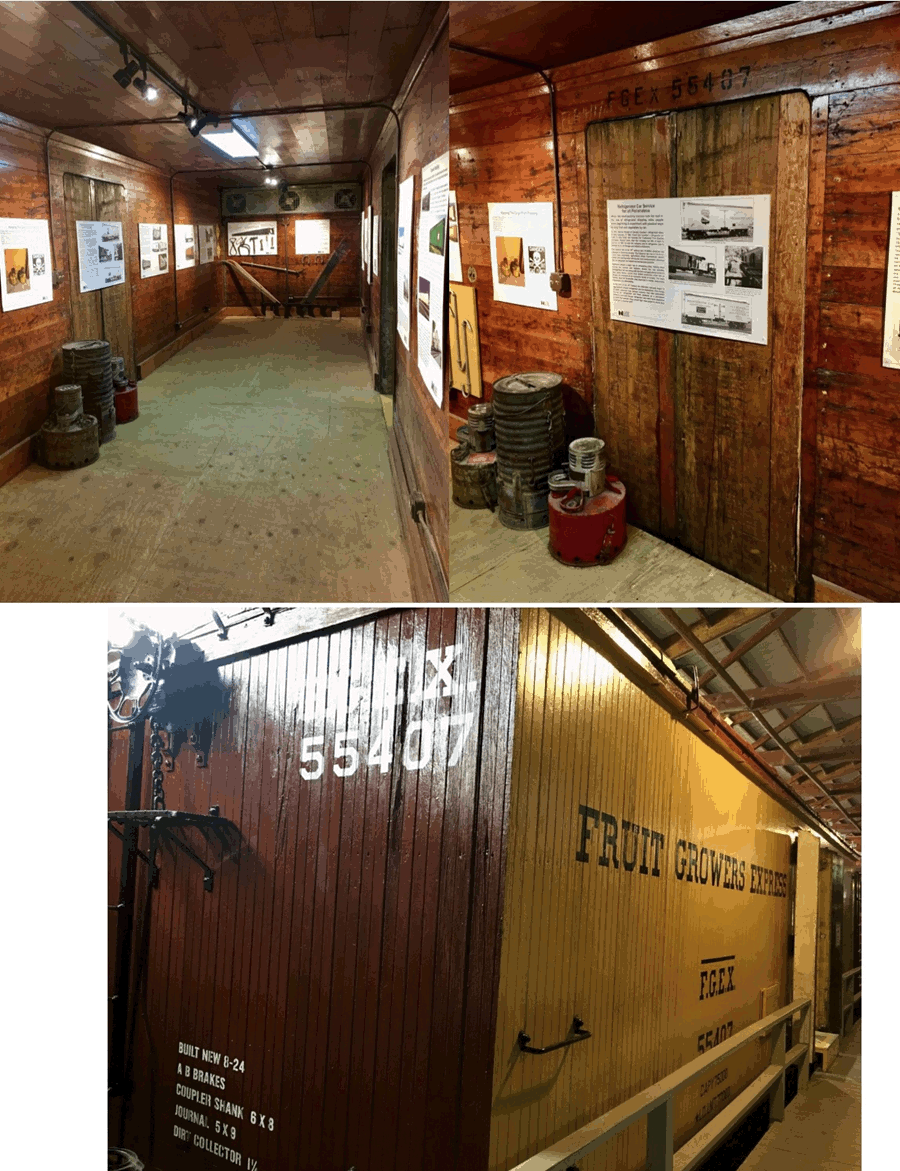
Fruit Growers Express (FGEX) #55407 RS Wood Reefer – Built 1924 (IRM in Union, Illinois – Koltz)
Note fans along far back wall
Steel constructed mechanical reefer cars with 6- or 8-foot sliding plug doors entered revenue service in the mid-1950’s. The diesel-powered cooling system maintained a more consistent internal temperature and eliminated the cost of manual labor and ice to keep the car cool. Developed primarily for hauling frozen foods and produce, the mechanical reefer led to the slow demise of the ice bunker. The last batch of ice bunker cars were built in 1956 and ice service was discontinued during the early 1970’s.
Although the mechanical reefer was a great advancement in railroad freight service, the meat industry preferred the ice bunker car – keeping it a mainstay of the rail fleet throughout the 1960’s. Besides begin inexpensive to build – the ice bunker cars were easy to maintain, had no mechanical devices to malfunction and the older wooden cars were judged to be better insulators than the newer steel constructed reefers.
Wilson & Co. was a Chicago-based meatpacker, who along with Armour, Swift and Cudahy were known collectively as the “Big Four” in the meat industry from the 1910’s through the 1950’s. Wilson & Co. origins began in the 1850’s New York slaughterhouse of Schwartzchild & Sulzberger. Overexpansion and the Recession of 1914 placed Schwartzchild & Sulzberger (S&S) into financial difficulty.
Thomas E. Wilson was appointed president of ‘S&S’ in 1916, renamed the business ‘Wilson Co.’ and relocated its headquarters to the Chicago Union Stock Yards. Furthermore, Wilson acquired the Hetzinger Knitting Mills to enter the growing athletic merchandise market. Initially producing uniforms and golf balls before expanding into football and basketball manufacturing. Wilson & Co. was a mainstay in the Chicago business community until Thomas E. Wilson’s death in 1960. In 1967 Ling-Temco-Vought (LTV) acquired the company and moved its headquarters to Dallas, Texas. Only three years later LTV sold-off the athletic product line, Wilson Sporting Goods, to PepsiCo. Wilson & Co. was renamed Wilson Foods Corporation in 1976.
Lastly, amongst several acquisitions and filings throughout the years, IBP Inc. (Iowa Beef Processors) acquired whatever was left of Wilson Foods Corporation in 1997 until Tyson Foods purchased IBP Inc. and control of all remaining Wilson meat brands in 2001.
Wilson & Co., like most large meatpacking companies, managed their own fleet of distinctively painted ice bunker cars. The meatpackers preferred the 36-foot wood sheathed car well into the 1960’s. Beside the before mentioned insulation properties, many wood ice bunker cars were equipped with meat rails that allowed sides of meat to hang and glide on hooks along the rails for ease of loading and unloading. The typical ice bunker had a lower door height of five feet to accommodate the height of the rails and limit the loss of cool air escaping the car. Also, unlike produce cars, the meat ice bunkers were equipped with brine tanks without ventilator service – hatches left ajar up top or circulating fans tend to dry-out the meat. The meat reefer had an elevated, pallet-like rack floor to allow cool to circulate below the hanging carcasses.
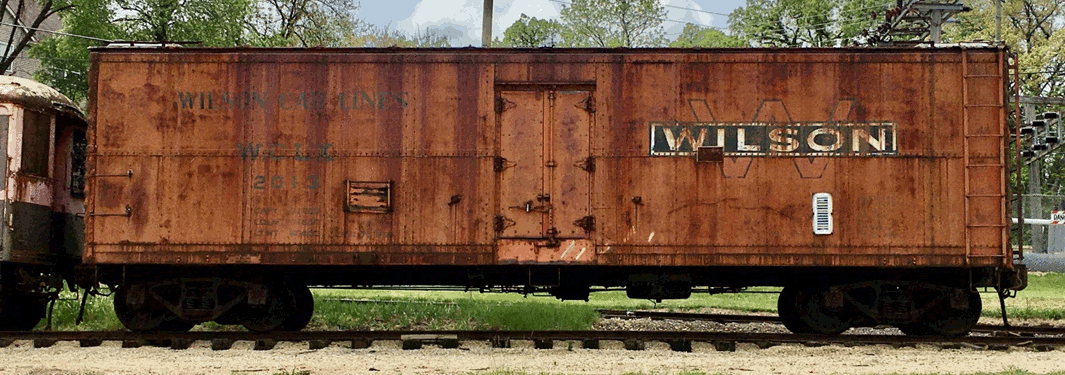
Wilson Car Lines (WCLX) Steel Reefer #2013- Built June 1957
(Fox River Trolley Museum in South Elgin, Illinois –Koltz)
The Wilson & Co. post-Billboard Era wooden cars were painted in a yellow-orange color with a small Wilson logo (‘W’ with Wilson & Co.) or just the Wilson Car Lines identifier. In the 1950’s, Wilson & Co. purchased 800 42-foot steel cars and painted all cars orange with a larger logo and eliminating ‘Co.’ from the side panels. Additionally, Wilson & Co. ordered 200 56-foot steel cars in the 1960’s with 6-foot sliding plug doors while retiring most of their wood reefer fleet.

Fox River Trolley Museum in South Elgin, Illinois –Koltz
Unfortunately for the railroads, all these advancements in refrigerated railcars could not compete with the growing highway system and the trucking industry. The Chicago, Burlington & Quincy (CB&Q) tried one last effort to reclaim meat traffic from trucks with the Burlington Beef Express in 1969. With over 400 40-foot refrigerated trailers, Burlington offered high-speed piggyback service from Denver to Chicago then onward to eastern cities. This attempt failed with the service being discontinued in 1971.
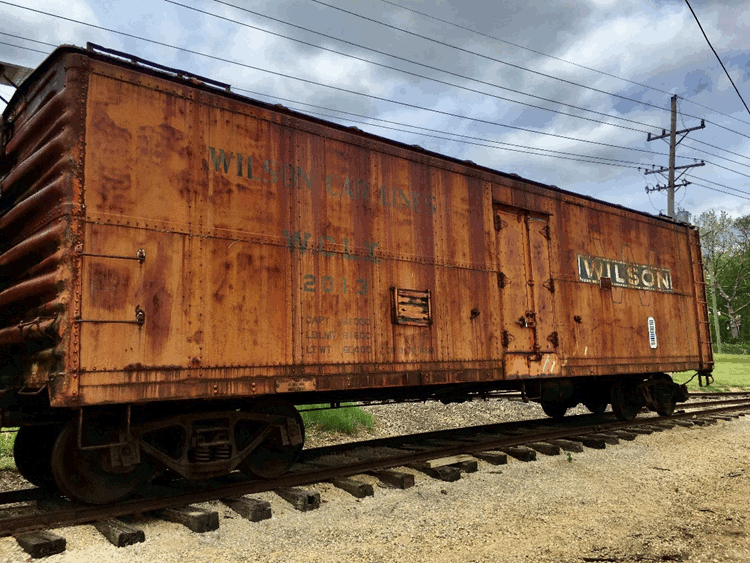
Fox River Trolley Museum in South Elgin, Illinois –Koltz
Railroads managed their own fleet of privately-owned refrigerated cars to repress some of the government restrictions placed upon them by ‘leasing’ some of their railcars to the newly formed ventures. For example, a decorated meat car was dedicated to a specific packing company – a Wilson & Co. reefer would not be allowed to haul Swift products. But a Pacific Fruit Express (PFE) car could bring grapefruit from California to Chicago to then haul corn to Utah on the same railcar. This also helped to alleviate the problem of dedicated service cars running half-the-time empty on return trips to the customer – cars held loads more often.

Some of the many privately owned Reefer Operators

Model with Box
The paint job is crisp and even along the entire injection molded plastic model. The Wilson & Co. car is painted in their recognizable orange color with black ends and silver roof. Lettering is extremely neat and clear, even when some magnification is needed for the smaller printing. All of the diminutive letters and numbers are readable - even the directive to “Return Empty Via Reserve Route.” Rivet lines are sharp, and hinge and lock details are finely casted.
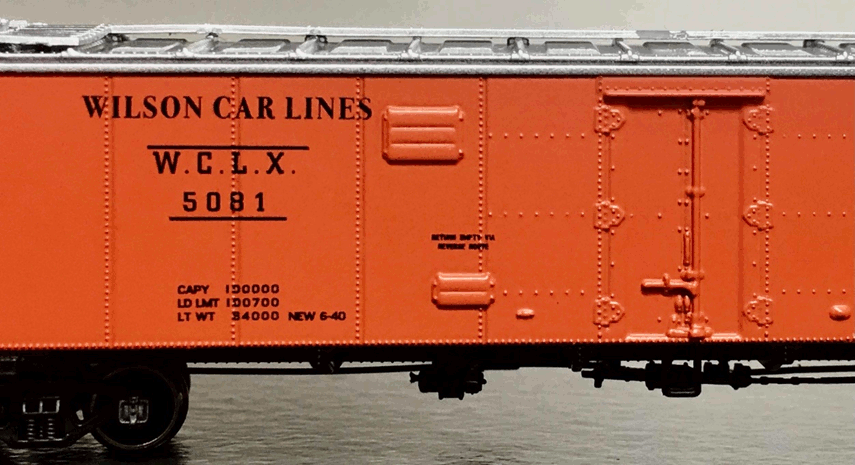
Crisp Paint and Lettering – Sharply Detailed Rivets – Santa Fe-Style Swing Door Hinges
The sides of the model closely resemble prototype images of Wilson Car Lines (WCLX) #5126 – a 56-foot steel reefer equipped with sliding plug doors (photos taken in 1966). The Athearn model and the prototype each share a riveted 12-panel (6x6) side configuration, stirrup steps, two grab irons on the near end and a full-length ladder on the far end. The Athearn model is painted and stenciled in the era correct font, color and size when compared to the real-life refrigerator car. The only major differences noted are the door types and location of the placard boards. The prototype is fitted with a plug door while the Athearn model represents a swing door with six Santa Fe shop designed short hinges and a vertical locking rod. Refrigerated doors were heavily insulated and strong hinges were necessary to provide a tight seal. Additionally, the tack boards on the prototype are mounted low, while the model has them mounted high. The AAR safety rules in the mid-1950's were updated to move the placard boards from up high (usually read by brakemen or at a loading dock) to down low to be seen by trainmen on the ground.
Both ends feature molded full height ladders, a high mounted placard board, and a basic 4/4 dreadnaught end pattern with small side darts between corrugations. The brake end shows a high mounted Ajax wheel with brake rods and brake step platform. Again, the lettering is neat and in proper arrangement with the road marker & road number in the top right of each end.

End Details - Standard 4/4 Dreadnaught - Extended Running Board
The riveted silver panel roof features an extended running board, lateral running boards on both ends and corner grab irons atop the full-length body ladders. If you note from a photograph above, the horizontal running board is mounted uneven along the top of the ice bunker car. Further highlighted are nicely tooled Santa Fe-style Equipco reversed ice hatches in all four corners of the roof.

Rivet Steel Panel Roof with Santa Fe-Style Ice Hatches
The black underframe has an elaborate pipe arrangement with highly detailed separately applied features such as the brake cylinder, braking system components, stringers, and cross bearers. The brake rigging is visible while riding along the tracks when viewed from the side – same as the prototype model. This adds an extra sense of realism and interest for the modeler. The ice bunker is fitted with screw mounted trucks with blackened metal wheels. Finally, the model is equipped with proper height body mounted McHenry knuckle spring couplers.

Detailed Underframe
The car is 3 7/8 inches in length and weighs about 1.1 ounces, which is perfect according to the National Model Railroad Association (NMRA) recommendations (which are 1.1 - 1.2 ounces for this size car). I found it an excellent runner while testing the car on Kato Unitrack with no issues around curves or through turnouts at slow and medium speeds. Another top-quality freight model car by Athearn Trains – fantastic paint job, fine detailed roof and braking system pieces, “close-enough” prototype accurate features and a great running, well-balanced car that needed no adjustments. Athearn was honest up-front that this was a fantasy paint scheme for this ice bunker release – the non-Santa Fe road names are not for the modeler that prefers to only run ‘true-to-life' rolling stock. But this is a winner for those willing to look the other way and want an exceptional ice bunker car in their favorite paint scheme.
To see a list of all cars in this series, CLICK HERE.
Road Names and Pricing
This latest release includes five different paint schemes. The road names represented in this collection include:- Fruit Growers Express (FOBX)
- Northern Pacific (NP)
- Rath Packing Company (RPRX)
- Wilson Car Lines (WCLX)
Also made available are:
- Santa Fe (SFRD)
My review includes observations of Wilson Car Lines (WCLX) #5081 – Athearn Trains stock number ATH2375.
Prototype History
During the early days of the North American railroads, local merchants had a predicament trying to expand their businesses to more markets. Produce, dairy and meat products were prone to spoilage and damage during handling and transit times. The first attempts to cool a railcar and pack a standard boxcar with ice were a failure. Then in 1867, J.B. Sutherland designed and patented the first successful refrigerated car to transport meat, produce and other perishable goods greater distances along the rails.Sutherland’s railcar design included ice tanks (bunkers) at each end of an insulated car to cool the load. The ice bunkers were manually filled through hatches on the car roof. Intake vents located atop the railcar allowed air to pass over the ice and circulate the cool air throughout the car. These early refrigerated cars were all wood construction between 28 to 32 feet long with wooden underframes and truss rods. The cars had vertical sheathing double walls with insulation between the voids. Early insulation was inadequate, usually sawdust, charcoal or animal hairs that tended to settle to the bottom on the car and left uninsulated areas along the higher portions of the car. At the turn of the 20th century the refrigerated car grew to 36-feet with 20-ton capacity along steel underframes and felt animal hair blanket insulation. Furthermore, swinging hinged doors became commonly used for their tighter seal over conventional doors and the fact that these doors were built thicker and had better insulation properties.

The refrigerated car matured along with the expanding national railroad systems. The post-World War I period saw the growth of the reefer to 40-feet, 30-ton capacity with steel roofs. Over 60% of the meat reefers built during this era were equipped with brine tanks instead of standard ice bunkers at each end of the car. The brine tanks held a mixture of crushed ice and salt that provided a much lower interior temperature than ice alone. The brine tanks did create a problem for the railroads with drippings of the salt concoction causing corrosive damage to the railcar, tracks, and bridges and the extensive cleanup needed at the end of each trip.
During the World War II era 40-foot riveted steel side panel reefers were introduced with a 40-ton capacity. Steel dreadnaught ends and better insulation (Celotex, cork, and fiberglass) became common. Although 40-feet in length, the refrigerated car had smaller interior load accommodations than a boxcar of the same size. Each end possessed an ice bunker 3-feet in length and the thickness of insulated walls and ceiling hatches made an interior dimension closer to 33-feet in length, 8-feet wide and 7-feet high. The car required 9,000 to 11,000 pounds (about twice the weight of an elephant) of ice to fill the bunkers and depending on the length of the trip, would require stops along the way to be ‘re-iced’.

Library of Congress Farm Security Administration/Office of War Information Black-and-White Negatives Public Domain
Delano, J., photographer. (1943) San Bernardino, California. United States, 1943. Mar. [Photograph] Retrieved from the Library of Congress, https://www.loc.gov/item/2017849845/
In 1941, interior air fan systems were developed – mounted high on each end of the interior, fans forced cool air throughout the refrigerated car. The fans were powered initially by a direct drive arrangement with rubber wheels in contact with a wheel on the railcar. Later, the fans were mechanized by generators or electrical power.

Note fans along far back wall
Steel constructed mechanical reefer cars with 6- or 8-foot sliding plug doors entered revenue service in the mid-1950’s. The diesel-powered cooling system maintained a more consistent internal temperature and eliminated the cost of manual labor and ice to keep the car cool. Developed primarily for hauling frozen foods and produce, the mechanical reefer led to the slow demise of the ice bunker. The last batch of ice bunker cars were built in 1956 and ice service was discontinued during the early 1970’s.
Although the mechanical reefer was a great advancement in railroad freight service, the meat industry preferred the ice bunker car – keeping it a mainstay of the rail fleet throughout the 1960’s. Besides begin inexpensive to build – the ice bunker cars were easy to maintain, had no mechanical devices to malfunction and the older wooden cars were judged to be better insulators than the newer steel constructed reefers.
Wilson & Co. was a Chicago-based meatpacker, who along with Armour, Swift and Cudahy were known collectively as the “Big Four” in the meat industry from the 1910’s through the 1950’s. Wilson & Co. origins began in the 1850’s New York slaughterhouse of Schwartzchild & Sulzberger. Overexpansion and the Recession of 1914 placed Schwartzchild & Sulzberger (S&S) into financial difficulty.
Thomas E. Wilson was appointed president of ‘S&S’ in 1916, renamed the business ‘Wilson Co.’ and relocated its headquarters to the Chicago Union Stock Yards. Furthermore, Wilson acquired the Hetzinger Knitting Mills to enter the growing athletic merchandise market. Initially producing uniforms and golf balls before expanding into football and basketball manufacturing. Wilson & Co. was a mainstay in the Chicago business community until Thomas E. Wilson’s death in 1960. In 1967 Ling-Temco-Vought (LTV) acquired the company and moved its headquarters to Dallas, Texas. Only three years later LTV sold-off the athletic product line, Wilson Sporting Goods, to PepsiCo. Wilson & Co. was renamed Wilson Foods Corporation in 1976.
Lastly, amongst several acquisitions and filings throughout the years, IBP Inc. (Iowa Beef Processors) acquired whatever was left of Wilson Foods Corporation in 1997 until Tyson Foods purchased IBP Inc. and control of all remaining Wilson meat brands in 2001.
Wilson & Co., like most large meatpacking companies, managed their own fleet of distinctively painted ice bunker cars. The meatpackers preferred the 36-foot wood sheathed car well into the 1960’s. Beside the before mentioned insulation properties, many wood ice bunker cars were equipped with meat rails that allowed sides of meat to hang and glide on hooks along the rails for ease of loading and unloading. The typical ice bunker had a lower door height of five feet to accommodate the height of the rails and limit the loss of cool air escaping the car. Also, unlike produce cars, the meat ice bunkers were equipped with brine tanks without ventilator service – hatches left ajar up top or circulating fans tend to dry-out the meat. The meat reefer had an elevated, pallet-like rack floor to allow cool to circulate below the hanging carcasses.

The Wilson & Co. post-Billboard Era wooden cars were painted in a yellow-orange color with a small Wilson logo (‘W’ with Wilson & Co.) or just the Wilson Car Lines identifier. In the 1950’s, Wilson & Co. purchased 800 42-foot steel cars and painted all cars orange with a larger logo and eliminating ‘Co.’ from the side panels. Additionally, Wilson & Co. ordered 200 56-foot steel cars in the 1960’s with 6-foot sliding plug doors while retiring most of their wood reefer fleet.

Unfortunately for the railroads, all these advancements in refrigerated railcars could not compete with the growing highway system and the trucking industry. The Chicago, Burlington & Quincy (CB&Q) tried one last effort to reclaim meat traffic from trucks with the Burlington Beef Express in 1969. With over 400 40-foot refrigerated trailers, Burlington offered high-speed piggyback service from Denver to Chicago then onward to eastern cities. This attempt failed with the service being discontinued in 1971.

Railroads managed their own fleet of privately-owned refrigerated cars to repress some of the government restrictions placed upon them by ‘leasing’ some of their railcars to the newly formed ventures. For example, a decorated meat car was dedicated to a specific packing company – a Wilson & Co. reefer would not be allowed to haul Swift products. But a Pacific Fruit Express (PFE) car could bring grapefruit from California to Chicago to then haul corn to Utah on the same railcar. This also helped to alleviate the problem of dedicated service cars running half-the-time empty on return trips to the customer – cars held loads more often.

The Model
The ready-to-run boxcar comes packaged in a transparent plastic jewel case with a slip-off cover and a thick two-piece plastic cradle to support the model. The model information is clearly labeled on the end of the case for ease to locate when in storage. There were two typographical errors found on this insert – the misspelling of Ice (Lce) and lower case ‘c’ for Wilson Car Lines. A thin plastic sleeve was also wrapped around the car to protect the print job from scuffmarks.
The paint job is crisp and even along the entire injection molded plastic model. The Wilson & Co. car is painted in their recognizable orange color with black ends and silver roof. Lettering is extremely neat and clear, even when some magnification is needed for the smaller printing. All of the diminutive letters and numbers are readable - even the directive to “Return Empty Via Reserve Route.” Rivet lines are sharp, and hinge and lock details are finely casted.

The sides of the model closely resemble prototype images of Wilson Car Lines (WCLX) #5126 – a 56-foot steel reefer equipped with sliding plug doors (photos taken in 1966). The Athearn model and the prototype each share a riveted 12-panel (6x6) side configuration, stirrup steps, two grab irons on the near end and a full-length ladder on the far end. The Athearn model is painted and stenciled in the era correct font, color and size when compared to the real-life refrigerator car. The only major differences noted are the door types and location of the placard boards. The prototype is fitted with a plug door while the Athearn model represents a swing door with six Santa Fe shop designed short hinges and a vertical locking rod. Refrigerated doors were heavily insulated and strong hinges were necessary to provide a tight seal. Additionally, the tack boards on the prototype are mounted low, while the model has them mounted high. The AAR safety rules in the mid-1950's were updated to move the placard boards from up high (usually read by brakemen or at a loading dock) to down low to be seen by trainmen on the ground.
Both ends feature molded full height ladders, a high mounted placard board, and a basic 4/4 dreadnaught end pattern with small side darts between corrugations. The brake end shows a high mounted Ajax wheel with brake rods and brake step platform. Again, the lettering is neat and in proper arrangement with the road marker & road number in the top right of each end.

The riveted silver panel roof features an extended running board, lateral running boards on both ends and corner grab irons atop the full-length body ladders. If you note from a photograph above, the horizontal running board is mounted uneven along the top of the ice bunker car. Further highlighted are nicely tooled Santa Fe-style Equipco reversed ice hatches in all four corners of the roof.

The black underframe has an elaborate pipe arrangement with highly detailed separately applied features such as the brake cylinder, braking system components, stringers, and cross bearers. The brake rigging is visible while riding along the tracks when viewed from the side – same as the prototype model. This adds an extra sense of realism and interest for the modeler. The ice bunker is fitted with screw mounted trucks with blackened metal wheels. Finally, the model is equipped with proper height body mounted McHenry knuckle spring couplers.

The car is 3 7/8 inches in length and weighs about 1.1 ounces, which is perfect according to the National Model Railroad Association (NMRA) recommendations (which are 1.1 - 1.2 ounces for this size car). I found it an excellent runner while testing the car on Kato Unitrack with no issues around curves or through turnouts at slow and medium speeds. Another top-quality freight model car by Athearn Trains – fantastic paint job, fine detailed roof and braking system pieces, “close-enough” prototype accurate features and a great running, well-balanced car that needed no adjustments. Athearn was honest up-front that this was a fantasy paint scheme for this ice bunker release – the non-Santa Fe road names are not for the modeler that prefers to only run ‘true-to-life' rolling stock. But this is a winner for those willing to look the other way and want an exceptional ice bunker car in their favorite paint scheme.
To see a list of all cars in this series, CLICK HERE.

